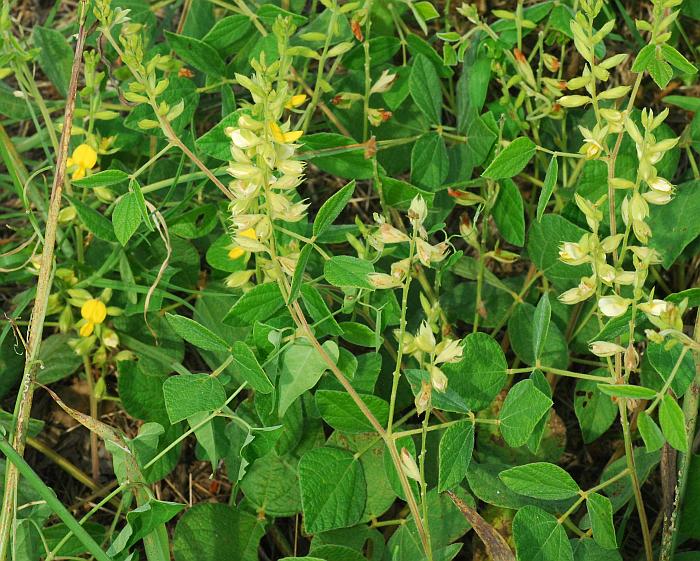Rhynchosia latifolia Nutt. ex Torr. & A. Gray
Snout Bean

Native
CC = 9
CW = 5
MOC = 16
© SRTurner
Rhynchosia latifolia Nutt. ex Torr. & A. GraySnout Bean | |
 |
Native CC = 9 CW = 5 MOC = 16 |
© SRTurner |
|
Family - Fabaceae/Faboideae Habit - Perennial herbs with thick, woody rootstocks. Stems - Prostrate, trailing, twining, sometimes ascending, branched, to 1.5 m, densely pubescent with downward-angled hairs. Leaves - Alternate, pinnately trifoliate, the petiole to 5 cm. Stipules 2-5 mm, lanceolate, hairy. Leaflets to 7.5 cm, broadly ovate to somewhat rhombic, entire, short-hairy. Undersurface dotted with minute yellow glands and raised venation.
Inflorescences - Elongate, relatively open racemes 5-18 cm long, longer than the subtending leaves, with mostly 10-20 flowers, the main stalk 5-20 mm long. Bracts 3-7 mm long, linear to narrowly lanceolate. Flower stalks 1-3 mm long.
Flowers - Calyces moderately to densely pubescent with fine, ascending hairs, also dotted with minute, globose resin glands, the tube bell-shaped, shorter than the lobes, more or less 2-lipped, the upper 2 lobes fused to at or above the midpoint, the free portions narrowly triangular-ovate, the lower 3 lobes as long as or slightly shorter than the other lip, narrowly oblong-elliptic to lanceolate, all of the lobes angled or tapered to sharply pointed tips. Corollas papilionaceous, yellow to orangish yellow, short-stalked, glabrous or short-hairy on the outer surface. Stamens 10, all of similar lengths, 9 of the filaments fused and 1 free to about the midpoint. Ovary sessile, densely hairy and usually also glandular, the style curved upward, thickened toward the tip, glabrous, the stigma terminal, minute.
Fruits - Legumes, 15-20 mm long, 7-9 mm wide, flattened, beaked, dark brown at maturity, densely hairy, 2-seeded. Seeds 3-4 mm long, flattened, the surface brown, reddish brown, gray, or black, sometimes with darker mottling, smooth, shiny.
Flowering - June - September. Habitat - Glades, savannas, dry upland forests, sand prairies, sandy disturbed areas. Origin - Native to the U.S. Lookalikes - R. difformis. Other info. - This plant is fairly uncommon, found in a few scattered counties in the southern half of the state. Its North American distribution extends in a band from Missouri southward through eastern Texas. The genus is recognized by its gland-dotted leaves, yellow flowers, and small, 2-seeded legumes. Differentiation from the other species which occurs in Missouri, R. difformis, can be challenging. Photographs taken near Blodgett, Scott County, MO, 8-28-2015, and at the Missouri Prairie Foundation sand prairie near the Charleston Baptist Association, Scott County, MO, 7-12-2021 (SRTurner). |